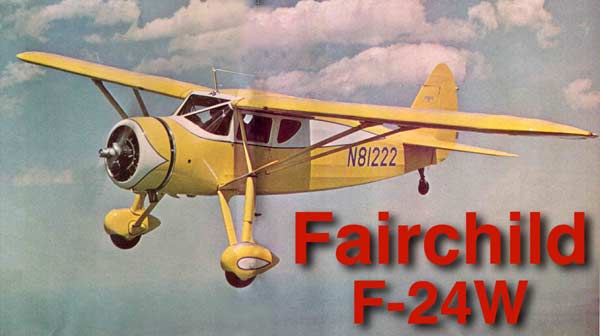
 |
Leisurely Limousine |
Do you believe in reincarnation? Personally, I'm holding my decision on that until I see what happens after I've turned on to final approach to that great runway up yonder. Of course, there are some folks who believe in reincarnation so strongly that they swear even mechanical objects will be reborn in another form. I'm not sure I'm willing to go for that but, if I did, 1'd be certain of one fact: When 1946 Packards die, they are reincarnated as Fairchild F-24Ws.
As antique airplanes go the Fairchild 24 has been slow to catch on. Until very recently, it was extremely unusual to see one sell for much more than a good Tripacer. It possessed none of the classic lines of many antiques, and it had to work hard to look anything but frumpy, especially when parked next to a Staggerwing or anything similar. In recent years, however, the little F-24 has been getting its share of attention and more and more of them are beginning to show up at fly-ins all gussied up and ready to vie for prizes.
But, then, super-clean is what most local folks expect out of Probst. He freely admits that he has a hang-up on neatness. He said that inspections in the Army were no sweat for him because the Army expected less neatness than he did. He's the kind of guy who probably has his "T" shirts starched and military creases ironed into them. This guy's so clean he doesn't even leave fingerprints. Marty is proud of his Fairchild, but he's just a little aggravated at the same time. "People see the glitter on my airplane and they always think its been modified," he says with a trace of bitterness. "This airplane is as original as any airplane ever restored and we can prove it." Apparently one thing that sets a lot of folks off about his airplane is the constant speed prop. They say the F-24 never had a constant speed so it can't be original. Of course, they never say that to Marty's face, because if they did, he'd whip out a pile of documents that show a certification date of 1942 on the Fairchild/constant speed prop combination. However, he will admit that the only airplanes that had this combination were flown in Australia and they were damned few. If really pressured, he'll also admit that the chrome PK screws and the shiny step on his air-plane aren't totally original either. But that's all. If you're really interested, and you'd better be interested or don't enquire, ask Marty about the trials and tribulations of getting a Warner 165 built up. He went through three rebuilds before he got it done right. And now it's as perfect as his "T" shirts. During the times we flew the airplane, not once did the engine have the nerve to put a drop of oil anywhere on the airplane, not even on the inside of the cowling. That may not mean much to a generation weaned on flat motors but most of us who have flown radials know that, if there isn't oil on the windshield, the engine is out of oil.
|